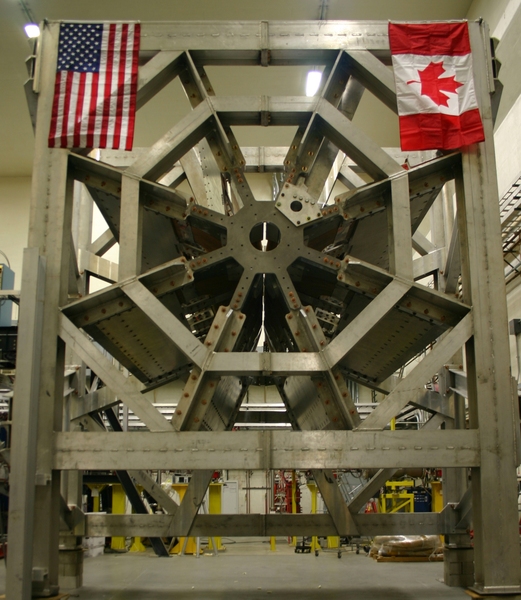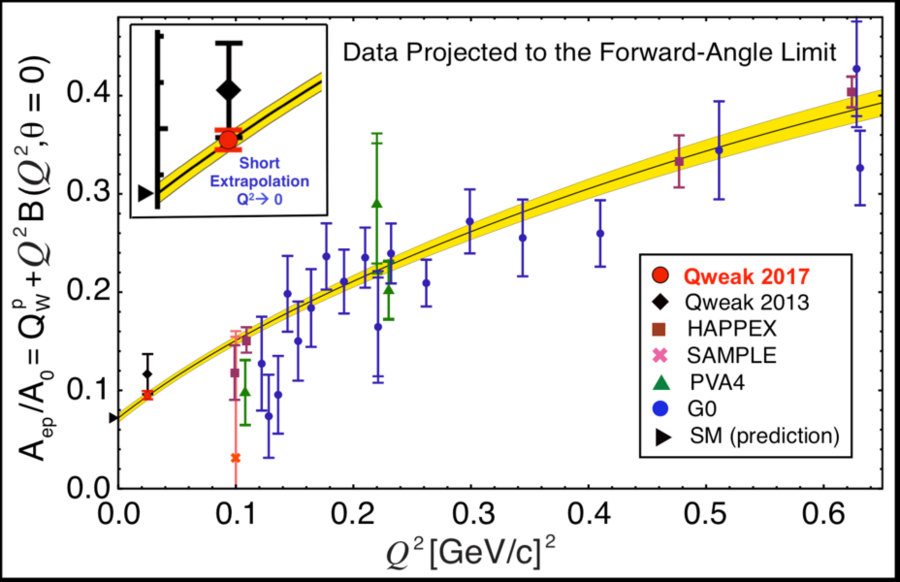A new result from the Qweak experiment at the U.S. Department of Energy’s Thomas Jefferson National Accelerator Facility provides a precision test of the weak force, one of four fundamental forces in nature. This result, published recently in Nature, also constrains possibilities for new particles and forces beyond our present knowledge.
The Qweak experiment has set new standards in precision tests of the Standard Model, a highly successful theory of fundamental particles and their interactions. It directly probed the physics only reached at the highest energy particle accelerators. MIT efforts were directed by Stanley Kowalski, a professor of physics and researcher in the Laboratory for Nuclear Science (LNS), who has pioneered parity violation studies over the past four decades starting in 1980, at the MIT-Bates Linear Accelerator Center, a part of LNS. Other MIT contributors to the work included postdocs W. Deconinck, Jean-Francoise Rajotte, and Rupesh Silwal. Fang Gao, a physics graduate student, analyzed Qweak data for her PhD thesis. Several MIT undergraduates also worked on many aspects of this experiment.
While the weak force is difficult to observe directly, its influence can be felt in our everyday world. For example, it initiates the chain of reactions that power the sun and it provides a mechanism for radioactive decays that partially heat the Earth’s core and that also enable doctors to detect disease inside the body without surgery.
Now, the Qweak Collaboration has revealed one of the weak force’s secrets: the precise strength of its grip on the proton. They did this by measuring the proton’s weak charge to high precision, which they probed using high-quality beams available at the Continuous Electron Beam Accelerator Facility, a Department of Energy Office of Science User Facility.
The proton’s weak charge is analogous to its more familiar electric charge, a measure of the influence the proton experiences from the electromagnetic force. These two interactions are closely related in the Standard Model, which describes the electromagnetic and weak forces as two different aspects of a single force that interacts with subatomic particles.
To measure the proton’s weak charge, an intense beam of electrons was directed onto a target containing cold liquid hydrogen, and the electrons scattered from this target were detected in a precise, custom-built measuring apparatus. The key to the Qweak experiment is that the electrons in the beam were highly polarized — prepared prior to acceleration to be mostly “spinning” in one direction, parallel or anti-parallel to the beam direction. With the direction of polarization rapidly reversed in a controlled manner, the experimenters were able to latch onto the weak interaction’s unique property of parity (akin to mirror symmetry) violation, in order to isolate its tiny effects to high precision: a different scattering rate by about 2 parts in 10 million was measured for the two beam polarization states.
The proton’s weak charge was found to be QWp=0.0719±0.0045. This turns out to be in excellent agreement with predictions of the Standard Model, which takes into account all known subatomic particles and the forces that act on them. Because the proton’s weak charge is so precisely predicted in this model, the new Qweak result provides insight into predictions of hitherto unobserved heavy particles, such as those that may be produced by the Large Hadron Collider (LHC) at CERN in Europe or future high-energy particle accelerators.
“This very challenging experimental result is yet another clue in the worldwide search for new physics beyond our current understanding. There is ample evidence the Standard Model of Particle physics provides only an incomplete description of nature’s phenomena, but where the breakthrough will come remains elusive,” says Timothy J. Hallman, associate director for nuclear physics of the U.S. Department of Energy Office of Science. “Experiments like Qweak are pressing ever closer to finding the answer.”
For example, the Qweak result has set limits on the possible existence of leptoquarks, hypothetical particles that can reverse the identities of two broad classes of very different fundamental particles, turning quarks (the building blocks of nuclear matter) into leptons (electrons and their heavier counterparts) and vice versa.
"After more than a decade of careful work, Qweak not only informed the Standard Model, it showed that extreme precision can enable moderate-energy experiments to achieve results on par with the largest accelerators available to science," says Anne Kinney, assistant director for the Mathematical and Physical Sciences Directorate at the National Science Foundation. "Such precision will be important in the hunt for physics beyond the Standard Model, where new particle effects would likely appear as extremely tiny deviations."
“It’s complementary information. So, if they find evidence for new physics in the future at the LHC, we can help identify what it might be, from the limits that we’re setting already in this paper,” says Greg Smith, Jefferson Lab senior staff scientist and Qweak project manager.
Kowalski had management responsibilities for the project, as a co-spokesperson. MIT also made very significant contributions to Qweak in two technical areas. Engineers and technicians at the MIT-Bates Laboratory designed, assembled, and tested the large toroidal magnetic spectrometer, QTOR, which directed the scattered electrons to the detectors. QTOR was magnetically mapped and certified by MIT-Bates personnel. Engineers and technicians also designed and built the Compton Polarimeter magnets and beamline, used to measure the polarization of the electron beam. These efforts at MIT-Bates were directed by LNS principal engineers James Kelsey and Ernest Ihloff. Jason Bessuille, who led the QTOR assembly effort as an engineering student, now works at MIT-Bates as a mechanical engineer.
An experiment such as Qweak is a superb training ground for future scientists and engineers. As such, MIT postdocs and students managed data acquisition efforts and data analysis.
Kowalski says, "Qweak provides a very precise measurement of the weak charge of the proton, probing interesting new physics at the highest energies."
The Qweak Collaboration consists of about 100 scientists and more than 20 institutions. The experiment was funded by the U.S. Department of Energy Office of Science, the National Science Foundation, the Natural Sciences and Engineering Research Council of Canada, and the Canadian Foundation for Innovation, with matching and in-kind contributions from a number of the collaborating institutions. The MIT effort was funded by a grant from the U.S. Department of Energy.







